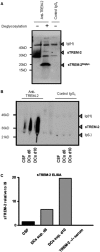Identification of soluble TREM-2 in the cerebrospinal fluid and its association with multiple sclerosis and CNS inflammation
- PMID: 18790823
- PMCID: PMC2577803
- DOI: 10.1093/brain/awn217
Identification of soluble TREM-2 in the cerebrospinal fluid and its association with multiple sclerosis and CNS inflammation
Abstract
Triggering receptor expressed on myeloid cells 2 (TREM-2) is a membrane-bound receptor expressed by microglia and macrophages. Engagement of TREM-2 on these cells has been reported to reduce inflammatory responses and, in microglial cells, to promote phagocytosis. TREM-2 function is critical within the CNS, as its genetic deficiency in humans causes neurodegeneration with myelin and axonal loss. Blockade of TREM-2 worsened the mouse model for multiple sclerosis. In the present study, a soluble form of TREM-2 protein has been identified by immunoprecipitation and by ELISA. Soluble TREM-2 protein (sTREM-2) was detected in human CSF, and was compared among subjects with relapsing-remitting multiple sclerosis (RR-MS; n = 52), primary progressive multiple sclerosis (PP-MS; n = 21), other inflammatory neurologic diseases (OIND; n = 19), and non-inflammatory neurologic diseases (NIND; n = 41). Compared to NIND subjects, CSF sTREM-2 levels were significantly higher in RR-MS (P = 0.004 by ANOVA) and PP-MS (P < 0.001) subjects, as well as in OIND (P < 0.001) subjects. In contrast, levels of sTREM-2 in blood did not differ among the groups. Furthermore, TREM-2 was detected on a subset of CSF monocytes by flow cytometry, and was also highly expressed on myelin-laden macrophages in eight active demyelinating lesions from four autopsied multiple sclerosis subjects. The elevated levels of sTREM-2 in CSF of multiple sclerosis patients may inhibit the anti-inflammatory function of the membrane-bound receptor suggesting sTREM-2 to be a possible target for future therapies.
Figures





References
-
- Bouchon A, Facchetti F, Weigand MA, Colonna M. TREM-1 amplifies inflammation and is a crucial mediator of septic shock. Nature. 2001a;410:1103–7. - PubMed
-
- Boven LA, Van Meurs M, Van Zwam M, Wierenga-Wolf A, Hintzen RQ, Boot RG, et al. Myelin-laden macrophages are anti-inflammatory, consistent with foam cells in multiple sclerosis. Brain. 2006;129:517–26. - PubMed
Publication types
MeSH terms
Substances
Grants and funding
LinkOut - more resources
Full Text Sources
Other Literature Sources
Medical
Miscellaneous

